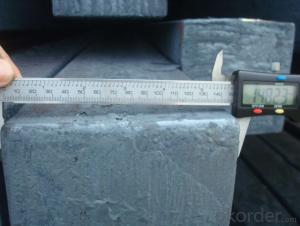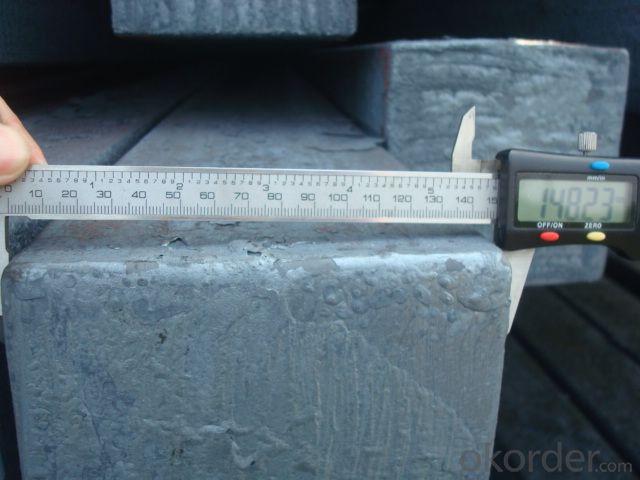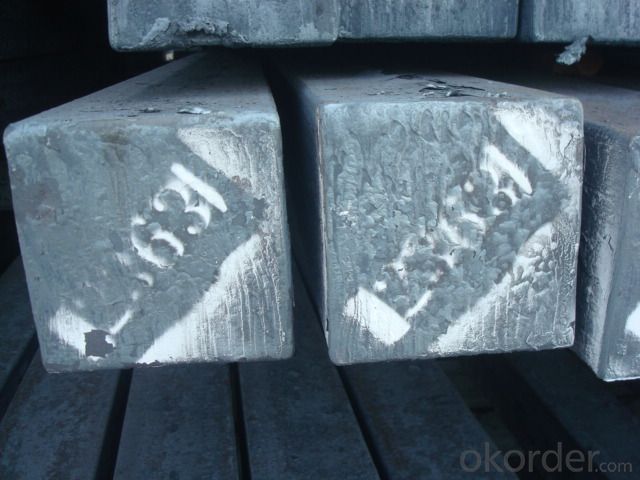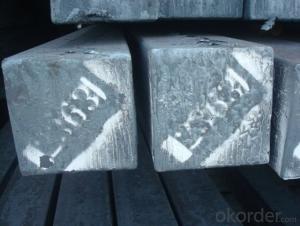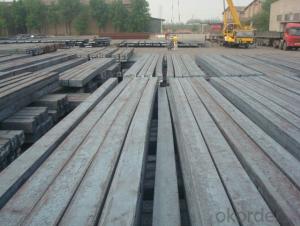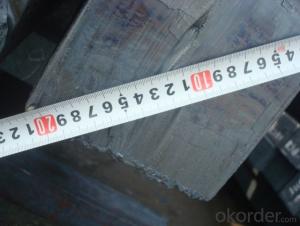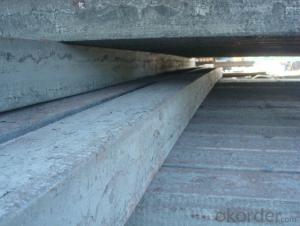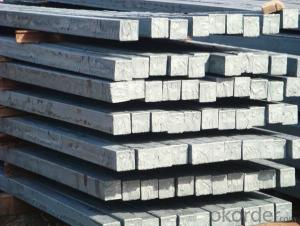Steel Billet Manufactured By Blasting Furnace
- Loading Port:
- Tianjin
- Payment Terms:
- TT OR LC
- Min Order Qty:
- 1000 m.t.
- Supply Capability:
- 100000 m.t./month
OKorder Service Pledge
OKorder Financial Service
You Might Also Like
Steel Billet Manufactured By Blasting Furnace
1.Structure of Steel Billet Manufactured By Blasting Furnace
Steel Billet Manufactured By Blasting Furnace is the raw material of all kinds of steel mill. Billet section of square, round, flat, rectangular and abnormity, etc Several, mainly related to shape of rolled products. Simple rolled section steel, choose cross section of square billet or rectangular billet. rolling The sector products such as flat steel, Angle steel, select the rectangular billet or slab. Had better profiled billet when production beams, channels, and in rolling process Lines and improve the yield. The raw material of round billet is the production of seamless tube.
2.Main Features of Steel Billet Manufactured By Blasting Furnace.
The classification of the billet Mainly from the shape is divided into two kinds: Slab: cross section width and height of the ratio of the larger, mainly used for rolling plate. Billet: equal cross section width and height, or a huge difference, mainly used for rolling steel, wire rod.
Billet material standard The thickness range: 150-240 - mm + / - 5 mm The width of the range: 880-1530 - mm + / - 20 mm Length range: 3700-10000 - mm + / - 500 - mm Cross-sectional size: 64 * 64 ; 82 * 82 ; 98 * 98 ; 124 * 124 ; 120 * 150 ; 152 * 164 ; 152 * 170 mm Length: 9000 mm The section of tolerance: billet: 1.0 + / - 2.0-1.0 + / - 1.0 mm The slab width: + / - 2.0 MM ; Thickness: + / - 3.0 MM
The length of tolerance: + / - 200 - mm The section diagonal tolerance: 3.5 8.0 MM Billet section size protrusions requirements: < 1242 mm Don't allow; = 1242 mm , > < = 2 mm to 1242 mm , The < = 3 mm beheaded ( shear ) Extension deformation: < 1242 mm Billet: no control; The slab: < = 15 mm Surface tilt: no more than in the cross section of the billet 0.1
3. Steel Billet Manufactured By Blasting Furnace Images
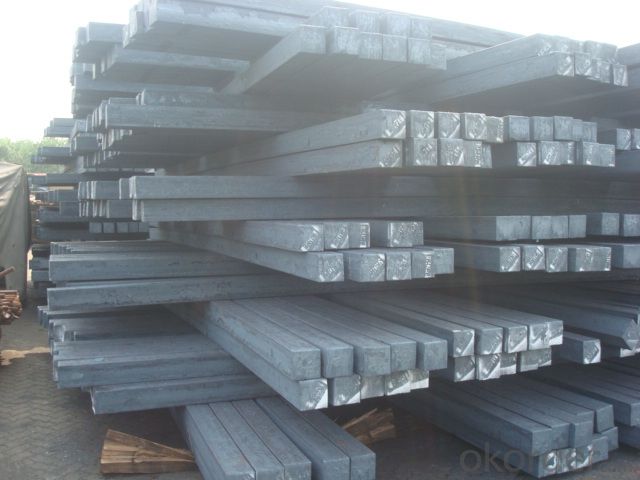
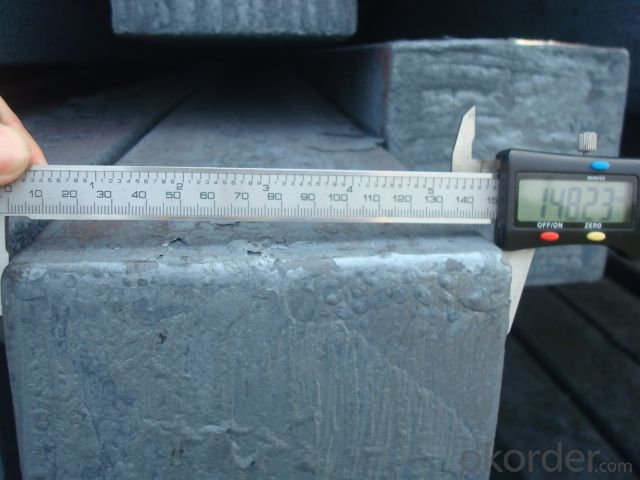
4. Steel Billet Manufactured By Blasting Furnace Specification
Steel Billet Manufactured By Blasting Furnace rolled steel, after processing can be used for mechanical parts, forging parts, processing all kinds of steel, steel Q345B channel steel, wire rod is the role of the billet. Steel billet is used in the production of semi-finished products, generally cannot be used directly for the society. Steel billets and steel are strictly divided into standard, cannot decide to whether the business enterprise of the final product, and according to unified standards to perform the whole society. Typically, billet and the steel is relatively easy to distinguish, but for some steel billet, and have the same specification and same steel purposes (such as rolling tube billet), whether can be used for other industries, whether through steel processing process, whether through a finished product rolling mill processing to distinguish
Material standard The editor Range of thickness: 150-240 - mm + / - 5 mm width range: 880-1530 - mm + / - 20 mm Length: 3700-10000 - mm + / - 500 - mm Cross-sectional size: 64 * 64; 82 * 82; 98 * 98; 124 * 124; 120 * 150; 152 * 164; 152 * 170 mm Length: 9000 mm Section of tolerance: billet: 1.0 + / - 2.0-1.0 + / - 1.0 mm slab: width: + / - 2.0 mm thickness: + / - 3.0 mm The length tolerance: + / - 200 mm Section diagonal tolerance: 3.5-8.0 MM Billet section size protrusions requirements: < 1242 mm, do not allow; > = 1242 mm, < = 2 mm 1242 mm, < = 3 mm Beheading (shear) extension deformation: < 1242 mm billet: no control; The slab: < = 15 mm Surface tilt: no more than billet section 0.1 Bending: every 1 m length is not more than 10 mm The distortion: length < = 5 m, < = 11. ; The length of the < = 7.5 M, < = 5. Material % 3 sp/PS chemical composition: C Mn Si S P
5.FAQ of Steel Billet Manufactured By Blasting Furnace
We have organized several common questions for our clients,may help you sincerely:
①How about your company?
A world class manufacturer & supplier of castings forging in carbon steel and alloy steel,is one of the large-scale professional investment casting production bases in China,consisting of both casting foundry forging and machining factory. Annually more than 8000 tons Precision casting and forging parts are exported to markets in Europe,America and Japan. OEM casting and forging service available according to customer’s requirements.
②How to guarantee the quality of the products?
We have established the international advanced quality management system,every link from raw material to final product we have strict quality test;We resolutely put an end to unqualified products flowing into the market. At the same time, we will provide necessary follow-up service assurance.
③How is the packaging and delivery?
Loose by Vessel and the delivery term is based on the the quantity and our factory’s schedule then.
- Q: How do steel billets contribute to the overall vibration resistance of a product?
- Steel billets are an essential component in enhancing the overall vibration resistance of a product. The high-strength properties of steel make it an ideal material for reducing vibrations and improving product stability. Steel billets are typically used as a raw material in the manufacturing process, where they are further processed into various shapes and forms. The dense and uniform structure of steel billets allows them to absorb and dissipate vibration energy effectively. When integrated into a product, steel billets provide additional mass, which helps dampen vibrations by absorbing and distributing the energy throughout the structure. This mass acts as a stabilizing force, preventing excessive movement and reducing the amplitude of vibrations. Moreover, steel billets possess excellent mechanical properties, such as high tensile strength and stiffness, which contribute to the overall vibration resistance of a product. These properties enable steel billets to withstand dynamic forces and resist deformation under vibration, ensuring the structural integrity of the product. Additionally, steel billets can be engineered to have specific geometries and cross-sectional shapes that further enhance their vibration resistance. For example, the use of round or square billets with smooth surfaces minimizes stress concentration points and reduces the risk of fatigue failure. By optimizing the design and dimensions of steel billets, manufacturers can tailor the vibration resistance of a product to meet specific requirements. In summary, steel billets play a crucial role in improving the overall vibration resistance of a product. Their high mass, dense structure, and superior mechanical properties enable them to absorb and dissipate vibration energy, stabilize the product, and enhance its structural integrity. By utilizing steel billets in the manufacturing process, manufacturers can ensure that their products are more resistant to vibrations, leading to improved performance and longevity.
- Q: How are steel billets used in the production of wind turbine towers?
- Steel billets play a crucial role in the production of wind turbine towers. These billets, which are essentially semi-finished steel products, are used as the raw material in the manufacturing process of wind turbine towers. Firstly, steel billets are carefully selected based on their specific properties such as strength, durability, and corrosion resistance. These properties are vital as wind turbine towers need to withstand strong winds, harsh weather conditions, and long-term exposure to environmental elements. Once the appropriate steel billets are chosen, they undergo a series of manufacturing processes. These processes often include heating, rolling, and shaping the billets into the desired form for wind turbine towers. Heating the steel billets to high temperatures makes them malleable and easier to shape. After the heating process, the steel billets are rolled into long cylindrical shapes, resembling the final structure of the wind turbine tower. These rolled billets are then forged and welded together to form seamless tower sections. The welding process ensures the structural integrity and stability of the tower. Furthermore, steel billets are also used in the construction of the tower's foundation. Large steel billets are embedded deep into the ground to provide a stable base for the tower. This helps to anchor the tower securely, preventing any potential movements or instability. Overall, steel billets are fundamental in the production of wind turbine towers as they provide the necessary strength and durability required for these structures. Without steel billets, it would be nearly impossible to construct wind turbine towers that can withstand the demanding conditions they are exposed to.
- Q: How long do steel billets typically last?
- Steel billets typically last for many years, as they are highly durable and resistant to corrosion. However, the specific lifespan of a steel billet depends on various factors such as the quality of the steel, the environment it is exposed to, and the usage conditions. With proper maintenance and care, steel billets can last for several decades.
- Q: What are the common sizes of steel billets used in construction?
- Construction projects can have varying requirements for the common sizes of steel billets used. Nevertheless, the construction industry typically employs several standard sizes. These sizes commonly range from 100 mm (4 inches) to 200 mm (8 inches) in width and 100 mm (4 inches) to 300 mm (12 inches) in height. While the length of the billets can also differ, they are often around 6 meters (20 feet) long. These standard sizes are readily accessible and widely available, making them a preferred choice for construction projects. However, it is worth noting that the actual sizes of steel billets used in construction can be tailored to match the specific needs and engineering requirements of a particular project.
- Q: Can steel billets be used in the aerospace industry?
- Yes, steel billets can be used in the aerospace industry. Steel billets are a semi-finished product that can be further processed into various components and structures required for aerospace applications. Steel is known for its high strength, durability, and heat resistance, which are crucial properties for aerospace materials. Steel billets can be used to manufacture various aerospace components such as engine parts, landing gear, structural frames, and fasteners. Additionally, steel's availability and cost-effectiveness make it an attractive choice for certain aerospace applications. However, it is important to note that the specific requirements and standards of the aerospace industry must be met when using steel billets to ensure the highest level of safety and reliability.
- Q: How are steel billets used in the production of industrial pumps?
- Steel billets are used in the production of industrial pumps as they serve as the raw material for creating the pump's main components, such as the pump body and impeller. These billets are melted, cast, and then forged or machined into the desired shapes and sizes to form the pump's robust and durable structure.
- Q: How are steel billets used in the manufacturing of food processing equipment?
- Steel billets are used in the manufacturing of food processing equipment as they serve as the primary raw material for shaping and forming various components such as frames, supports, blades, and cutting tools. These billets are heated, rolled, and machined into desired shapes and sizes to create durable and robust equipment that can withstand the demanding conditions of food processing operations while ensuring hygiene, safety, and efficiency.
- Q: What are the different types of steel billet heat treatment processes?
- There are several types of steel billet heat treatment processes, including annealing, normalizing, quenching, and tempering. Annealing involves heating the billet to a high temperature and then slowly cooling it to relieve internal stresses and improve its ductility. Normalizing is similar to annealing but involves cooling the billet in still air to achieve a more uniform grain structure. Quenching is a rapid cooling process that involves immersing the billet in a quenching medium, such as water or oil, to achieve high hardness and strength. Tempering follows quenching and involves reheating the billet to a lower temperature to reduce brittleness and enhance toughness.
- Q: What are the potential applications of steel billets in the electronics industry?
- The electronics industry can benefit from the potential applications of steel billets. While steel is not traditionally associated with this sector, advancements in technology have allowed for its use in various ways. One potential application is using steel billets to produce electronic enclosures. These enclosures offer superior durability and protection for electronic components. They can withstand harsh environments, provide electromagnetic shielding, and prevent damage from impacts or accidents. Manufacturers have the flexibility to shape and form steel billets into different enclosure designs to meet specific requirements. Another application is in manufacturing connectors and terminals. Steel billets can be machined and formed into intricate shapes and sizes, making them suitable for creating reliable and strong connectors. Steel connectors offer excellent conductivity, ensuring efficient and secure connections between electronic components. Additionally, steel's resistance to corrosion makes it a viable option for connectors exposed to moisture or other harsh conditions. Steel billets can also be used to produce high-strength structural components in electronic devices. These components, such as brackets, frames, or supports, require materials with exceptional strength and rigidity. Steel billets, with their high strength-to-weight ratio, provide the necessary structural integrity and stability. Their robustness ensures the longevity and reliability of electronic devices, especially those subjected to heavy loads or vibrations. Furthermore, steel billets can find applications in manufacturing heat sinks. Heat sinks are crucial for dissipating heat generated by electronic components and preventing overheating. Steel, with its excellent thermal conductivity, efficiently transfers heat away from sensitive electronic parts. By shaping steel billets into heat sink designs, manufacturers can create effective cooling systems that enhance the performance and longevity of electronic devices. In conclusion, steel billets have numerous potential applications in the electronics industry. From electronic enclosures to connectors, structural components, and heat sinks, steel's durability, conductivity, and thermal properties make it a valuable material for electronic device production. As technology continues to advance, the use of steel billets in the electronics industry is expected to expand further, offering more innovative solutions for electronic manufacturers.
- Q: How are steel billets used in the production of marine equipment?
- Steel billets are an integral part of the production process for marine equipment. These billets, which are semi-finished steel products, serve as the raw material for manufacturing different components used in the construction of marine equipment such as ships, offshore platforms, and marine structures. Firstly, steel billets are used to create various structural elements of marine equipment, including hulls, decks, and bulkheads. These components provide the strength and stability necessary to withstand the harsh conditions of marine environments. The billets are heated and shaped through processes like rolling, forging, or extrusion to form the desired shapes and sizes of these structural elements. Additionally, steel billets are used to produce propeller shafts, rudders, and other propulsion system components. These parts are crucial for the movement and maneuverability of marine equipment. The billets are machined and further processed to create these specialized components, ensuring their durability and reliability in demanding marine conditions. Moreover, steel billets are employed in the production of marine equipment accessories such as anchors, chains, and mooring systems. These accessories play a vital role in ensuring the stability and safety of vessels and offshore structures. The billets are transformed into the required shapes and sizes through casting, forging, or machining processes to meet the specific requirements of each accessory. Furthermore, steel billets are also utilized in the manufacturing of marine equipment fittings, including valves, pipes, and fittings for fluid and gas systems. These components are essential for the proper functioning of various systems on board vessels, such as fuel, water, and hydraulic systems. The billets are processed and machined to create these fittings, ensuring their compatibility with marine-grade materials and their ability to withstand corrosive marine environments. In summary, steel billets are crucial in the production of marine equipment as they serve as the primary raw material for creating structural elements, propulsion system components, accessories, and fittings. By using steel billets, manufacturers can ensure the strength, durability, and reliability of marine equipment, enabling them to withstand the challenging conditions of the marine environment and ensuring the safety and performance of vessels and offshore structures.
Send your message to us
Steel Billet Manufactured By Blasting Furnace
- Loading Port:
- Tianjin
- Payment Terms:
- TT OR LC
- Min Order Qty:
- 1000 m.t.
- Supply Capability:
- 100000 m.t./month
OKorder Service Pledge
OKorder Financial Service
Similar products
Hot products
Hot Searches
Related keywords
